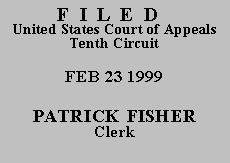

| JANE DOE, also known as
John Andrew Cuoco ,
v.
JANET RENO; KATHLEEN M.
HAWK, BOP Director; JOHN M.
HURLEY, Warden of ADX Florence,
Colorado |
No. 98-1252
(D.C. No. 98-D-271) (Colorado) |
Jane Doe, a/k/a John A. Cuoco, a pro se transsexual federal prisoner, brought this action under 28 U.S.C. § 2241, raising four claims. The district court dismissed the first three claims on the ground that petitioner had an adequate and effective remedy under 28 U.S.C. § 2255. The court dismissed the fourth claim upon concluding that it was in essence a challenge to the conditions of petitioner's confinement cognizable under Bivens v. Six Unknown Named Fed. Agents, 403 U.S. 388 (1971). Petitioner appeals. We grant petitioner's motion for leave to appeal in forma pauperis, and we affirm in part and reverse and remand in part.
In 1992, petitioner was convicted in the Southern District of New York on four counts of robbing United States Post Offices and sentenced to 168 months in prison. The conviction and sentence were affirmed on direct appeal in 1993. On April 21, 1997, petitioner allegedly filed a section 2255 action in the Southern District of New York, which was apparently still pending at the time the district court here issued its ruling. In this section 2255 petition, petitioner allegedly asserted four claims: that petitioner was improperly tried in absentia, that the trial court committed evidentiary errors, that petitioner's trial and appellate counsel were ineffective, and that the government committed prosecutorial misconduct. In the instant action under section 2241, petitioner claims that the trial in absentia in the Southern District of New York was improper, that the court imposed an invalid sentence, that trial and appellate counsel were ineffective, and that the current conditions of confinement are unconstitutional.
As we have previously pointed out:
A petition under 28 U.S.C. § 2241 attacks the execution of a sentence rather than its validity and must be filed in the district where the prisoner is confined. It is not an additional, alternative, or supplemental remedy to 28 U.S.C. § 2255.
A 28 U.S.C. § 2255 petition attacks the legality of detention, and must be filed in the district that imposed the sentence. "The purpose of section 2255 is to provide a method of determining the validity of a judgment by the court which imposed the sentence, rather than by the court in the district where the prisoner is confined."
"The exclusive remedy for testing the validity of a judgment and sentence, unless it is inadequate or ineffective, is that provided for in 28 U.S.C. § 2255."
Bradshaw v. Story, 86 F.3d 164, 166 (10th Cir. 1996) (citations omitted).
The district court held that the first three claims asserted in this proceeding challenging the validity of petitioner's conviction and sentence must be brought under section 2255 in the district that imposed the sentence. We agree. We reject petitioner's argument that pursuing a section 2255 action in the sentencing district is inadequate and ineffective because that district may well dismiss the proceeding as untimely. "Failure to obtain relief under 2255 does not establish that the remedy so provided is either inadequate or ineffective." Id. (internal quotations and citations omitted). Accordingly, we affirm the dismissal of the first three claims.
The district court characterized the fourth claim as one challenging petitioner's conditions of confinement, Rec., Order of Dismissal, at 4-5, a characterization that appears justified on the basis of the pleadings before us. Although the court also recognized that such a claim is cognizable under Bivens, the court nonetheless dismissed it. Id. at 6. Petitioner argues on appeal that the court erred in dismissing the claim rather than allowing it to proceed as a Bivens action, and we agree. Pro se pleadings are to be liberally construed. See Haines v. Kerner, 404 U.S. 519, 520 (1072). Petitioner's claim challenging the conditions of confinement should have been construed as a complaint under Bivens. See Wilwording v. Swenson, 404 U.S. 249, 251 (1971) (per curiam) (construing dismissed habeas claims as section 1983 claims and remanding for further proceedings). See also Royce v. Hahn, 151 F.3d 116, 118 (3d Cir. 1998); Graham v. Broglin, 922 F.2d 379, 381-82 (7th Cir. 1991); Hall v. Flowers, No. 97-6200, 1998 WL 3461 (10th Cir. Jan. 6, 1998). We therefore remand this claim to the district court for consideration of petitioner's claim as a civil rights action concerning the conditions of confinement.
We AFFIRM the dismissal of the first three claims. We REVERSE the district court's dismissal of the fourth claim and REMAND for further proceedings.
ENTERED FOR THE COURT
Stephanie K. Seymour
Chief Judge
*.This order and judgment is not binding precedent, except under the doctrines of law of the case, res judicata, or collateral estoppel. The court generally disfavors the citation of orders and judgments; nevertheless, an order and judgment may be cited under the terms and conditions of 10th Cir. R. 36.3.